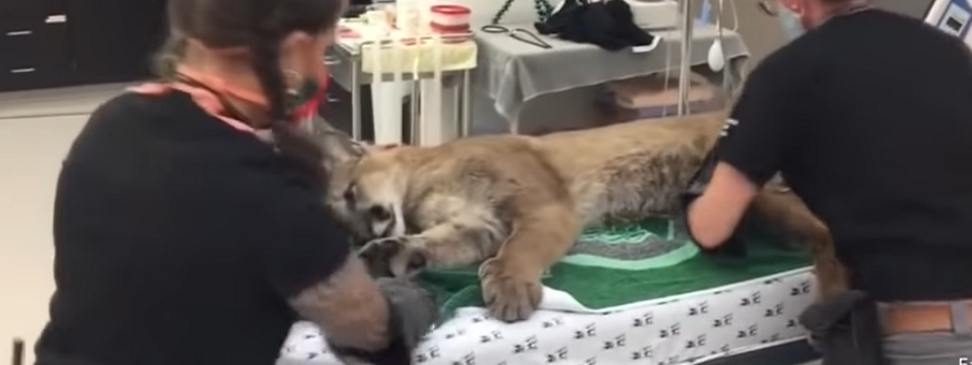When Big City Meets Big Kitty

It’s been a few weeks now since our weary COVID gaze was momentarily enlivened by the sighting of a cat. For two days in mid-June we tuned in as a wild mountain lion walked the streets of San Francisco. We followed him by way of citizen smartphones and security cameras, popping up in the city landmarks of Russian Hill, the Embarcadero, Oracle Park. He jaywalked through headlights, strolled through outdoor malls, checked his reflection in vacant store windows and napped in city planters.
One might peg the San Francisco lion as yet another of the pandemic’s silver linings, of wildlife the world over now re-taking the deserted humanscape as we duck for cover from COVID. Wild boar rooting through the streets of Barcelona, wolves stalking deer in the center of Scanno, Italy. Roadkill stats—the death toll of animals typically smashed by our vehicles—are down by as much as half in recent surveys. The wild world’s jubilant reaction to a sudden absence of us has been so striking that we’ve named it—anthropause.
But the more poignant storyline of the San Francisco lion was what happened when the authorities finally caught up to him. On June 18, a team of two dozen officers from the city’s Animal Care & Control, the SFPD, and the California Department of Fish and Wildlife cornered the cat in a planter box near the Giants baseball stadium at Oracle Park. Noting that the lion was rather small (50 pounds as it would turn out), the team decided against darting it with dangerous tranquilizers and instead captured it with a net.
They then drove the frightened youngster to the Oakland Zoo for a checkup, fitted him with a radio tracking collar, and set him free in the wildlands south of the city, from where he was suspected of wandering.

Mr. San Francisco receives his checkup at the Oakland Zoo before his ride home.
Having watched one too many such city dramas end badly, I exhaled. Mountain lions do have the occasional habit of stumbling into the alien environs of the urban jungle. But those who do, seldom come out alive—at least those who happen to find themselves in some other city lacking a California address. If the San Francisco lion had instead been the Des Moines lion, or the Rapid City lion, or the Sioux City or Omaha or Bismarck or Fargo or El Paso or Chicago lion—or dozens of other Midwestern wanderers over the last few decades—he would have received bullets before benevolence, as every one of those cats did.
If that list of lethal cities suggests a certain geo-cultural divide, feel free to draw your own conclusions. But it’s the tender treatment afforded the San Francisco lion that intrigues me, that has me once again wondering what special breakfast juice those Californians are drinking.
California, Champion of Lions
The compassion on display in San Francisco is not an anomaly—at least not in California. California wildlife cops regularly escort lost lions safely out of town. Or when a complaint comes in from, say, a goat or alpaca farmer losing loved ones to a lion, the first official response is not to shoot the lion, but to better secure the goats. And if the farmer needs help on that end, there are groups like the Bay Area Puma Project and the Mountain Lion Foundation standing by to offer their expertise.
At least 10 organizations—non-profits, universities, national and state agencies—have programs dedicated to understanding and protecting California’s mountain lions. While every other western state with lions invites its citizens to hunt them, often with draconian vehemence, the citizens of California voted thirty years ago to outlaw lion hunting altogether.
California as a state is the country’s gold standard of lion love. Though to be fair, California does kill some of its cats. About a hundred a year are dispatched by farmers and contract killers, taking out lions that threaten people, or repeatedly raid corrals. Another hundred are killed by motorists. And an additional unregistered number disappear by way of the ubiquitous poacher. But in general, it’s safer being a mountain lion in California than just about any other place in the nation.
For the Californians’ show of kindness, their lions return the favor. Relative to the 10 states that hunt their lions, California has the third lowest rate of attacks on people (the odds of which are microscopically small to begin with). California doesn’t lose any more cattle to lions than the average state that hunts its lions, and California is significantly safer for sheep. Its deer herd is just as dense as those supposedly protected by lion hunters.
So while hunters and game agents and haters of lions in general continue to recite as gospel the three scientifically unfounded objectives for killing more mountain lions—to protect people, livestock, and game animals—Californians fare better on every count with their strategy of understanding and tolerance. They simply let their lions live.
Checking Facts, Calling Foul
These latest facts are lifted from a new paper by lion biologists John Laundre and Christopher Papouchis, putting statistical weight to bear on the wrongness of the anti-lion lobby. They are most recently seconded by fellow biologist Mark Elbroch, whose upcoming book, The Cougar Conundrum, debunks the myths at length. Add to this list the names of Adrian Treves, a predator researcher and leader of the Carnivore Coexistence lab out of the University of Wisconsin in Madison, and Bill Ripple of the Global Trophic Cascades Program at Oregon State University. They are among the leaders of a movement of concerned scientists using hard data, logic, and ethics to challenge the status quo of senseless violence against our fellow predators.
The ultimate perversity of America’s lion offensive is that the more we kill and the more suffering we inflict, the more dangerous life becomes for all of us. The dead cats leave behind starving orphans and reckless youngsters, collateral victims who in their desperations are those most likely to consider domestic and human animals as prey.
A possible case in point: Recall the stirring national story from February of 2019, of a young man in Colorado who, with his bare hands killed an 80-pound mountain lion as it attacked him on the trail. For all the dramatic headlines and breathless reporting that followed, what most people never heard was that the attacking lion actually turned out to be an orphaned, starving, 35-40 pound kitten. Its two siblings were later found, also starving. All of this in an area open to lion hunting, begging the question: What, or who, orphaned the kitten who attacked that young man?
It’s not just what we do to lions, it’s what we block them from doing for us. Absence of lions is one of the factors behind freakishly high populations of fearless deer, who in turn are obliterating the floral diversity of America’s forests. These are the same deer that kill some 200 of the million people who collide with them on the roads every year. These are the same deer that the game agencies promote at expense of all other wildlife, to sell more hunting licenses, to pay game agency salaries. These are the same game agencies who oppose all suggestions of bringing back their native lions. Bullets and bucks over biodiversity and human welfare.
“Where is the morality of these agencies?” asks Laundre. “How can they look at themselves in the mirror and not be ashamed of their actions?”
Persecution on Sight
These anti-predator prejudices are ignored at our own peril, for they have long, strangling tendrils. My dog Towpath, for example—technically a predator of the order Carnivora—is banned from certain cities, for nothing more than his look. His look is that of a block-headed, tank-bodied canine, arbitrarily labelled as pit bull. Because of his look, targeted by a pitbull smear campaign, many imbue his type with demonic powers. We’re told that he is a hair-triggered killing machine, with locking jaws and an utter absence of mercy. We’ve been warned by friends, worried that the beast who sleeps in our bed will one night rip out our throats as we sleep. And because we list such a monster as family, we pay a premium on our homeowner’s insurance from one of the few companies that will even consider us.
This societal menace that we harbor came to us as a four-month-old puppy, burned and beaten and abandoned for dead. This same dog now cheers sick children in hospitals, and comforts schoolkids learning to read. This dog has never met a stranger he finds undeserving of his affections. (See “Caution!” below.)

Caution! Serial kisser on the loose!
Pit bulls, mountain lions, and fellow predators all suffer the worst of injustices, rooted in a pervasive belief that we humans are inherently more worthy than others—a belief that morally justifies our mistreatment of them. Psychologists call this belief speciesism, recently identified as a close cousin to racism, sexism, and homophobia. There are stark and chilling parallels between our historic slaughter of mountain lions and our persecution of Black people (and genocide of American Indians)—as animals and subhumans undeserving of our sympathies. In light of our country’s current tinderbox of societal tensions and moral divides, our ongoing mistreatment of other creatures rings with an ominous, red-flag resonance. Yes, lion lives matter.
I end here with an update on our young San Francisco lion, though not as I would have hoped. On July 3, just two weeks after being returned to his wild home, he was found dead on the shoulder of Highway 1 near Pacifica, apparently struck by a car. A cruel twist of fate, perhaps. Or an indictment of our meddling, as some critics have accused: Did we really need to burden that 50-pound kitten with a collar?
For me the lion junkie, spectating from afar, his death more simply conjured a dark bit of déjà vu, recalling the summer of 2011 when a young wanderlust male from South Dakota somehow survived a treacherous trans-America tour covering 18 months and thousands of miles, only to die on a Connecticut highway.
But as with that cat, I’ll take my comforts in remembering the San Francisco lion for the brief time that he thrilled us with his presence, and reminded us of a certain wildness and oneness with the world we share. And however fleeting the moment, I’m heartened to know that there are those of us still willing to offer their hand to a stranger in their city.
Explore more
For an interactive presentation on the urban exploits of the cat they came to call, Mr. San Francisco, visit this Facebook page of the Felidae Conservation Fund.
And for those looking to learn more, here’s a partial list of organizations standing up for California’s lions. Following is some of their specific sites and programs:
This is wonderful, Will! May we reprint it in Rewilding Earth? We’ve been wanting articles from you, and this would fit beautifully.
Gratefully
John Davis
Rewilding Earth (rewilding.org) editor
Thanks John. Of course you’re welcome to use my LLM post however it suits. And thanks for considering it. I apologize for being too shy to suggest it myself.
Wonderful essay. Your book was excellent.
Thank you, Amy. So good to hear. The cats need all the friends we can muster.
Thank you Thank you I am sharing this with as many as I know
Please let us know how to help
as opportunity may arise